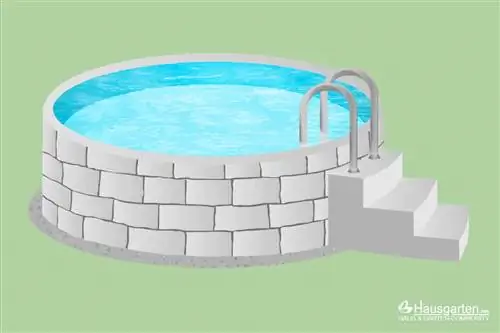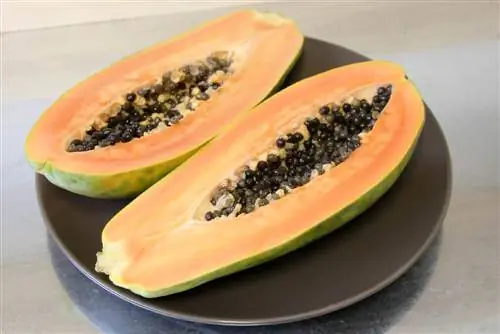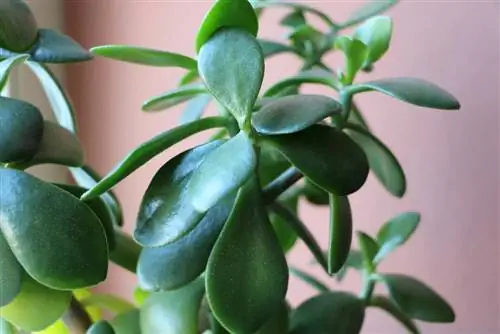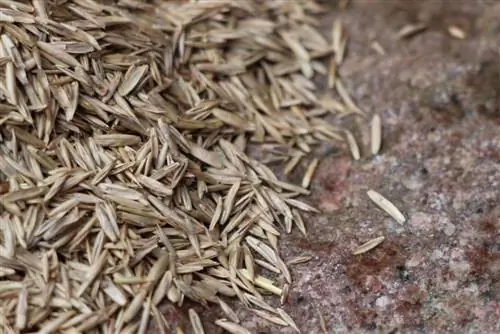- Author admin [email protected].
- Public 2023-12-17 03:39.
- Last modified 2025-06-01 06:48.
Enjoying drinking coffee and enjoying plants, combining these two characteristics inevitably leads to a coffee plant. The evergreen shrub, which is ideal for indoor cultivation, has a magnificent green foliage and even produces flowers and fruits under favorable conditions. The ripe berries invite you to spend a cozy moment with a cup of tasty coffee.
Profile
- Botanical name: Coffea arabica
- Plant family: Red family
- Origin: Ethiopia, equatorial regions
- Growth height: up to 150 cm
- Leaves: opposite, elongated-elliptical, slightly wavy, smooth edges
- Flowers: white, diameter approx. 2 cm, fivefold, sweetly scented
- Fruits: red cherries or berries, usually each with 2 seeds (coffee beans)
Plant shape
Strictly speaking, the coffee plant grows as a shrub whose upright shoots become woody. Specialist retailers usually sell the Coffea arabica species as a decorative green plant with shiny foliage for living areas. In addition to Arabica coffee, Coffea canephora (Robusta) is one of the most commonly grown varieties in coffee plantations. The plants used for the professional production of coffee beans reach heights of 5 m and more. When grown indoors and in containers, the maximum achievable size is significantly lower. Both sowing and rooting cuttings can be used to propagate exotic plants.
Location
Coffea arabica likes it bright and warm. The coffee plant offers a perfect environment:
- lots of light
- no bright sun (risk of burn damage to the leaves)
- Temperature: 20° - 25°C
- high humidity
- no drafts
- I like to be outside (in partial shade) during midsummer
- October to February a little cooler (hibernation for regeneration)
- never below 15°C
If the coffee plant in living rooms is misted with soft water once a day, it receives the necessary air humidity. Bowls filled with water placed next to the plant also release some water vapor into the air through evaporation. The coffee plant wants to develop freely. Being too close to other plants makes her uncomfortable. Therefore, give her the necessary distance so that she does not feel cooped up.
Tip:
Coffee plants grow towards the light. If the growth is crooked, turn the pot by 90°.
Substrate
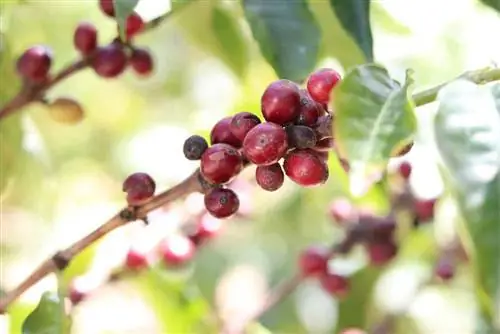
The coffee plant has certain demands on the soil. If the substrate does not meet her wishes, she reacts sensitively. Ideally, the substance surrounding the roots has the following properties:
- humos
- easy
- permeable
- sufficiently ventilated
- neutral to slightly acidic (ph value 5.5 - 6.5)
A mixture of potting soil, sand and pumice gravel comes very close to the requirements of the coffee plant, although in this combination the potting soil predominates proportionately (3:1:1). Instead of pumice gravel, expanded clay can be used as an alternative. To give the soil a slightly acidic character, you can replace half of the potting soil with rhododendron or azalea substrate. When using cactus soil, permeability is already ensured so that no moisture accumulates.
Tip:
In the wild, the coffee plant loves deep soil. To accommodate cultivation in our region, the planter should not be flat, but relatively high.
Pouring
Completely dried out substrate is very likely to cause the coffee plant to die. Therefore, you should always keep the root ball moist to a certain extent. There are the following criteria to consider when watering:
- lime-free water (e.g. rainwater)
- no cold water
- Exclude waterlogging
- Let the upper substrate layer dry slightly until the next watering
- water a little less during the winter rest phase
Fertilize
In addition to light, water, warmth and humidity, the coffee plant needs nutrients that support its development. Newly purchased or freshly repotted specimens usually initially have sufficient nitrogen, potassium, phosphorus and other minerals. But after about 8 weeks the supply in the substrate runs out. Then commercially available liquid fertilizer provides replenishment. Fertilize approximately every 14 days according to the instructions for use. During the rest phase, the plant cells work on a low flame, so stop fertilizing completely during this time.
Sowing
Roasted coffee beans are not capable of germinating because they have been heated strongly and no longer have any moisture. Coffee beans only get their characteristic brown color through the roasting process. If you want to grow coffee plants by sowing, you need untreated green coffee beans with a greenish-pale shell. Well-stocked seed retailers will certainly also carry coffee seeds.
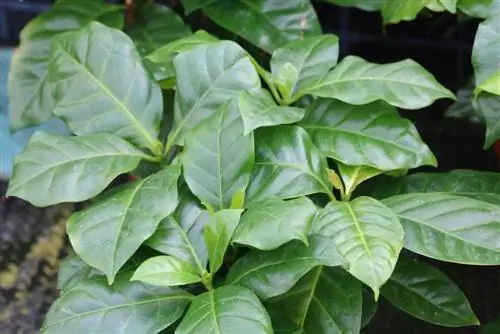
Or maybe you know someone who has a coffee plant that has already sprouted seeds. Sowing takes place in nutrient-poor potting soil or potting soil mixed with sand. The seeds germinate best in loose substrate, and sowing can take place all year round if the ambient temperature is right. Proceed as follows:
- Open drupes and remove seeds
- Let the seeds soak in lukewarm water for a few hours
- Fill pots with substrate
- Press seeds into the soil (planting depth approx. 1 cm)
- spray with water or pour carefully
- Put the freezer bag over the pot or cover with cling film
- Germination temperature: 20 - 25°C
- no direct sunlight
- Germination time: 4 to 8 weeks
- keep evenly moist, but do not over-wet
- ventilate daily to prevent mold
It's better to sow several seeds at the same time, because they often don't all sprout. It takes 1-2 months for the seedlings to emerge from the ground. Another two months later the first leaves have developed. With a height of 5 cm, the seedlings have finally outgrown the seedling stage. Since they have now become a little more resistant, they no longer need a cover. The plants still have to get used to the sun, which is why they prefer a partially shaded spot on an east or west window. Otherwise, you can now give the young plants the same care as larger plants.
Cuttings
In addition to sowing, vegetative propagation offers the opportunity to grow coffee plants yourself. Perhaps someone from your family or acquaintances will give you one or more offshoots. You need head cuttings, i.e. approximately 20 cm long, half-woody tips of a shoot. This is how rooting works:
- Fill growing soil into pots
- remove each sheet except for one pair above
- Place cuttings three quarters of their length in soil
- water and mist the cutting (lime-free water!)
- provided with a transparent hood
- Location: 25°C, bright but no direct sun
- Plant substrate must not dry out
- ventilate daily and spray again
- repot after root formation (in 2-3 months)
Tip:
Whether sowing or cuttings, a mini greenhouse provides the offspring with a perfect nursery.
Buying plants
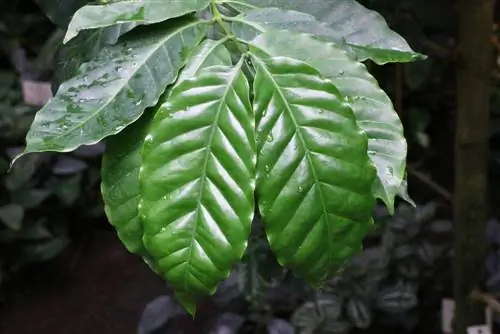
You don't want to sow or take cuttings? Nurseries, garden centers and various online shops have plants available for you to purchase. This way you can get coffee plants quickly and easily. Specimens purchased from specialist retailers usually have a height of 20 to 30 cm. They are therefore also still quite young. It also takes at least 3 years for these plants to bloom for the first time. Recognize he althy plants:
- well rooted ball
- compact growth
- strong green foliage
- no brown or curled leaves
- free from insect webs and pest infestation
- moist substrate (not dry and not wet)
Flowers
When your plant is decorated with fragrant flowers for the first time, the feeling of happiness will certainly increase immeasurably. So the long wait was worth it. The white splendor grows from the leaf axils in short-stemmed inflorescences. Seeds only develop from fertilized flowers. Coffea arabica is a self-pollinator, but it doesn't hurt if you give it a little help. To do this, take a soft brush and gently dab the flowers one after the other with its hair.
Fruits
After pollination, the fruit sets appear in the form of small, green balls. Over time, the cherries become thicker and change their appearance to a reddish hue. As soon as they present themselves in a deep red color, they are ready to harvest. The complete maturation process takes about a year. It may be that both fruits and flowers are on the bush at the same time.
Homemade coffee
It only takes a few days and a few steps after the harvest to have a relaxing coffee break:
- Removing seeds from the fruit peel
- let it dry in a warm place
- turn occasionally
- Roast dried beans in the pan at the highest level for 10 to 20 minutes
- Wait 1 to 6 days until the full aroma develops
- Grinding beans
- Screw coffee powder with boiling water
- Enjoy coffee
Repotting
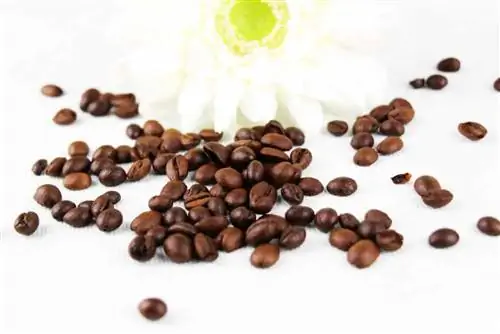
What looks like a bush in purchased specimens is actually individual plants. Garden centers usually put several saplings in one pot so that the product for sale looks fuller and therefore more attractive. The group can initially stay as it is. But at the latest when the plants fight for space with each other, they belong separately.
Whether each stem gets its own pot is up to you. It is important that the plants do not interfere with each other and that all leaves receive enough light. Since the next repotting will take place after 2-3 years anyway, separating can then possibly take place. There is an opportunity to check the roots during repotting. You can remove soft or even rotten parts. Provided with fresh soil, the plant does not require any fertilization in the following weeks.
Diseases and pests
If the leaves get brown spots or dry out completely, the cause is usually due to incorrect location and growth conditions. The plant is probably too wet or too dry, otherwise temperatures that are too cool or direct sunlight can damage the foliage. Light yellow discoloration is usually a sign of a nutrient deficiency. In the case of extremely deformed plants, experts recommend radical pruning and then optimal care so that the coffee plant recovers. Bacterial, viral or fungal diseases are highly unlikely. Only pests cause problems every now and then.
They include:
- Scale insects
- Mealybugs
- rarely aphids
Special products from retailers help against unwanted animals. When using biological substances, a solution of soft soap, water and a little alcohol has the most effective effect.
pruning
In and of itself, the growth of Coffea arabica progresses slowly. But over the years the plant reaches an impressive height. The space allotted to her may become too limited at some point. Then you can boldly grab the scissors, because coffee plants are very easy to cut. In the best case scenario, shortening takes place in the spring before new growth and above a leaf node. The coffee plant copes well even with vigorous pruning. It reacts with a bushy growth. You can use severed branches to propagate cuttings.
Tip:
Home-grown sprouts of Coffea arabica make every plant lover shine as a souvenir.


